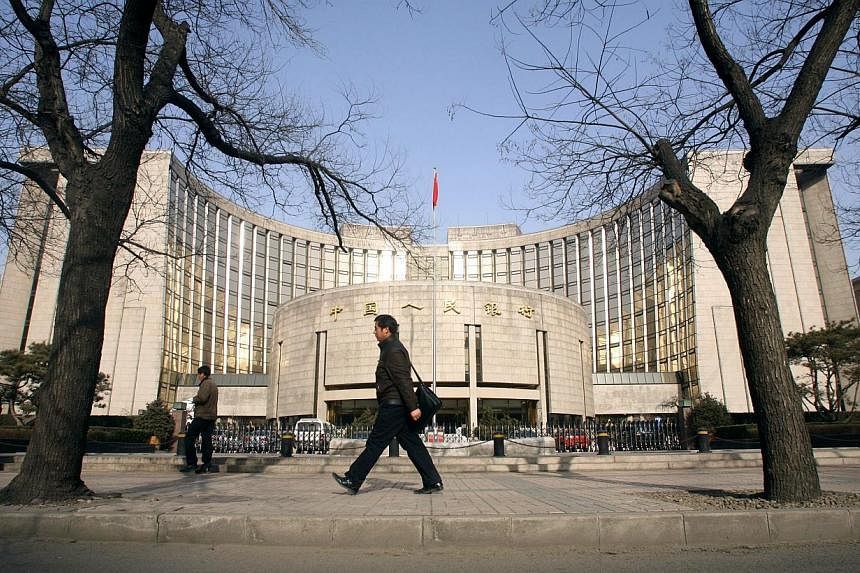BEIJING (BLOOMBERG) - China's central bank cut benchmark interest rates for the second time in three months as disinflation gives room to step up support for the nation's slowing economy.
The one-year deposit rate will be lowered by 25 basis points to 2.5 per cent and the one-year lending rate will also drop by a quarter percentage point to 5.35 per cent on March 1, the Beijing-based People's Bank of China (PBOC) said on its website late Saturday.
The move reflects deepening concern over an economy squeezed by a property slump, tighter controls over local government debt and rising capital outflows. By adding rate cuts to a reduction in the cash banks must set aside as reserves, the PBOC is intensifying its easing measures along with more than a dozen global counterparts this year as plunging commodity prices provide scope to support growth.
"A rate cut was urgently needed," said Wang Tao, the chief China economist at UBS Group AG in Hong Kong, who predicted one or two more reductions this year.
"The debt burden is heavy, and the PBOC has to act to keep the financial market stable."
The PBOC also increased the deposit-rate ceiling to 1.3 times from 1.2, meaning banks can pay a larger margin over the benchmark. That eases the financial repression that has seen China's savers effectively subsidize debt-funded investment.
The monetary authority lowered interest rates for the first time in two years in November.
- Rates Liberalisation -
"This time the PBOC acted very well," said Shen Jianguang, the chief Asia economist at Mizuho Securities Asia Ltd. in Hong Kong. "After two rate cuts, the financing costs will be cut down pretty effectively, but more rate reductions are still needed."
Shen expects the next reserve-ratio cut to come in late March, and the next rate reduction in April.
Allowing banks to pay a higher margin over the benchmark rate is "almost entire liberalization" of the deposit rate, meeting a pledge by Governor Zhou Xiaochuan, he said.
The central bank said that while the November rate cut achieved "certain effects" in lowering financing costs, economic restructuring and falling global commodity prices cut consumer and industrial prices in recent months, leading to higher real interest rates.
Consumer prices rose at the slowest pace in more than five years in January and factory-gate deflation deepened to the lowest level since 2009.
The rate reduction is aimed at creating a "neutral and appropriate" monetary environment, the PBOC said.
In a question and answer statement explaining the cut, the central bank said it doesn't "represent a change in the prudent monetary policy stance."
- Global Easing -
The PBOC joins central banks from Turkey to Japan and Australia as well as the euro area that have eased policy this year. The measures come as the Federal Reserve moves closer to increasing interest rates.
"After this PBOC rate cut, global monetary policies will further polarize," said Larry Hu, the head of China economics at Macquarie Securities Ltd. in Hong Kong, who expects another rate cut in Beijing and three more reserve-ratio reductions in 2015.
"As the Fed's rate hike is coming in June or September, the PBOC will react by stabilising the exchange rate and keeping capital from flowing out too rapidly."
The PBOC's cut in the required reserve ratio announced on Feb 4 was the first across-the-board reduction since May 2012. It followed a slump in the government's official manufacturing gauge that signaled contraction for the first time in more than two years in January. The factory gauge probably deteriorated further in February, economists said in a Bloomberg survey before a report on Sunday.
- Deflationary Pressures -
"The central bank is acting in response to rising deflationary and slowdown pressures," said Chang Jian, the chief China economist at Barclays Plc in Hong Kong. "The timing is interesting as well, coming just before the National People's Congress," which starts in Beijing next week.
Chang said the central bank will have to execute a "mix of interest-rate cuts and required-reserve ratio cuts" in 2015.
China's communist leaders gather for an annual meeting, where they are anticipated to unveil a growth target for 2015 of around 7 per cent, down from "about 7.5 per cent" last year.
Yang Zhao, China chief economist at Nomura Holdings Inc. in Hong Kong, said the reduction in borrowing costs was earlier than he had expected and is a signal that the economy remains weak.
"In general, the rate cut is in line with our view that the PBOC is ready to ease its monetary stance to counter headwinds for growth and disinflationary pressures," he said.

